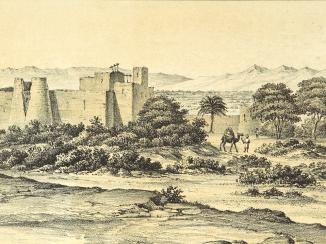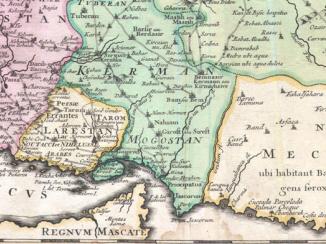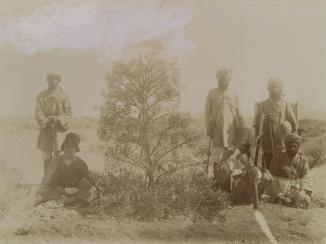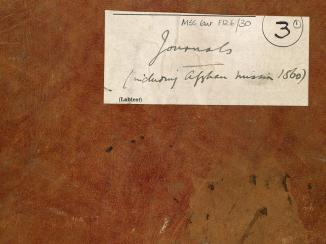Vol 108: Native Letters Inward
IOR/R/15/1/79
262 items in this record
Search within this record
The record is made up of 1 volume (260 pages). It was created in 2 Oct 1838-25 Aug 1839. It was written in English. The original is part of the British Library: India Office The department of the British Government to which the Government of India reported between 1858 and 1947. The successor to the Court of Directors. Records and Private Papers Documents collected in a private capacity. .
About this record
- Content
The volume consists of translations of (and substances of) letters in Arabic and Persian received by the British Residency An office of the East India Company and, later, of the British Raj, established in the provinces and regions considered part of, or under the influence of, British India. in the Persian Gulf The historical term used to describe the body of water between the Arabian Peninsula and Iran. ; the original letters are not present in the volume. The greatest proportion of this correspondence is from the Resident's native agents Non-British agents affiliated with the British Government. throughout the Persian Gulf The historical term used to describe the body of water between the Arabian Peninsula and Iran. at Bahrein [Bahrain], Lingah [Bandar-e-Lengeh], Muscat, Sharjah, and also from the News Writer The lowest of the four classes into which East India Company civil servants were divided. A Writer’s duties originally consisted mostly of copying documents and book-keeping. at Shiraz. Most of the remaining correspondence is from various Chiefs/Governors/Shaikhs from across the Gulf, their relations, or subjects; leaders from Persia and Oman are the most heavily represented.
Developments in Persia are a frequent inclusion in the correspondence, particularly with regard to news surrounding Shiraz, and the Government of Fars. Events surrounding the diplomatic rupture between the British and the Government of Bushire, and the temporary removal of the Residency An office of the East India Company and, later, of the British Raj, established in the provinces and regions considered part of, or under the influence of, British India. to Karak [Khārk, Jazīreh-ye] in March 1839 are also included, along with subsequent efforts by the Persians to induce the Resident to return.
Updates on the situation in Nejde [Najd] can also be found within. These cover the defeat of Ameer Fysul [Amīr Fayṣul] by Koorshid Pacha [Khūrshid Pāshā], the Commander of Egyptian Forces in Nejde, and the subsequent establishment of Ameer Khalid bin Soud [Amīr Khālid bin Sa'ud] as the Governor of that province. It therefore also includes reports on the Commander's efforts to induce the submission of Shaikh Abdulla bin Ahmed [Shaikh ‘Abdullāh bin Aḥmad Āl Khalīfah], Chief of Bahrein, to Egypt; he claims that the island is a tributary of Nejde. This includes the further efforts of his agent, Mahomed bin Muttuk, to secure the submission of the various Arab tribes in Oman; a move requiring the occupation of Braymee, held by the Naim tribe which is hostile to Egyptian expansion. As a result, accusations of collusion with this agent — made by the Arab Chiefs against each other — can also be found within; the main belligerents being Shaikh Sultan bin Suggur [Sulṭān bin Saqr], Chief of the Joasmees [ Qāsimī One of the ruling families of the United Arab Emirates; also used to refer to a confederation of seafaring Arabs led by the Qāsimī tribe from Ras al Khaima. ]; and Shaikh Kuleefa bin Shakboot [Khalīfah bin Shakhbūṭ], Chief of the Beniyas.
The conflict between Esa bin Tareef [‘Isá bin Ṭarīf] of the Al Ali tribe with the Chief of Bahrein is also featured to an extent, along with the abandonment of the Al Ali by the Chief of Beniyas, as a result of the increasing threat from Egyptian forces from Nejde.
The correspondence also includes material of a more routine nature, such as the relaying of letters and packets, to reports on the movements of British ships. It also includes reports relating to the restitution of property plundered at sea.
Please note that Bahrein is also spelt Bharein, and Shiraz is also spelt Sheeraz within the volume.
- Extent and format
- 1 volume (260 pages)
- Arrangement
The translations are arranged chronologically from 2 October 1838 to 25 August 1839, and are organised into sections by the month they were received at the Residency An office of the East India Company and, later, of the British Raj, established in the provinces and regions considered part of, or under the influence of, British India. in Bushire.
- Physical characteristics
Pagination: The volume contains an original pagination sequence, which commences at the first page of text and terminates at the last page; these numbers are written in ink (with additions in pencil), and can be found in the top outermost corners of each page. Page 225 has been omitted from this sequence; this is likely to be a result of human error.
- Written in
- English in Latin script
- Type
- Letter book
Archive information for this record
- Original held at
- British Library: India Office The department of the British Government to which the Government of India reported between 1858 and 1947. The successor to the Court of Directors. Records and Private Papers Documents collected in a private capacity.
- Access conditions
Unrestricted
- Archive reference
- IOR/R/15/1/79
- Date(s)
- 2 Oct 1838-25 Aug 1839 (CE, Gregorian)
Access & Reference
History of this record
Related search terms
- Subjects
- Imperial rivalry
- Places
- PersiaOmanBahreinNejdeBraymee
- People & organisations
- Governor of BushirePrince-Governor of Fārs, Qajar dynastyShah of Persia, Qajar dynastyNative Agent, LingahNative Agent, MuscatNative Agent, Trucial Coast, SharjahKing of BahrainEmir of Abu Dhabi, Āl Nahyān dynastyEmir of Sharjah, Āl Qāsimī dynastyEmir of Ra's al-Khaymah, Āl Qāsimī dynastyNewswriter at ShirazCommander-in-Chief of Egyptian Forces in Central Arabia
Use and share this record
- Share this record
- Cite this record in your research
Vol 108: Native Letters Inward, British Library: India Office Records and Private Papers, IOR/R/15/1/79, in Qatar Digital Library <https://www.qdl.qa/archive/81055/vdc_100000000193.0x000034> [accessed 20 April 2024]
- Link to this record
https://www.qdl.qa/en/archive/81055/vdc_100000000193.0x000034
- IIIF details
This record has a IIIF manifest available as follows. If you have a compatible viewer you can drag the icon to load it.https://www.qdl.qa/en/iiif/81055/vdc_100000000193.0x000034/manifestOpen in Universal viewerOpen in Mirador viewerMore options for embedding images
Copyright: How to use this content
- Reference
- IOR/R/15/1/79
- Title
- Vol 108: Native Letters Inward
- Pages
- front, front-i, i-r:ii-v, 1:225, 227:255, back-i, back
- Author
- East India Company, the Board of Control, the India Office, or other British Government Department
- Usage terms
- Open Government Licence











































































































































































































































































